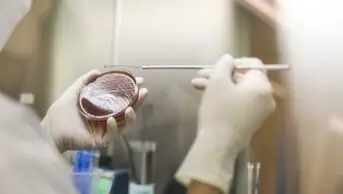
Ray Tang/REX/Shutterstock
Patients in developed countries should not be prescribed an antibiotic without first having a rapid diagnostic test to ensure the drug is appropriate and drug companies must be forced to do more to find new antibiotic drugs, the final report of the UK government’s Review on Antimicrobial Resistance (AMR)[1]
has recommended.
The report, which is led by economist Lord Jim O’Neill, looks at the implications of antimicrobial resistance and how best to tackle it. He says that one of the main reasons that antibiotics are overused is because effective rapid tests that confirm whether or not a patient needs antibiotics are not widely available, so doctors prescribe them “just in case”.
“I call on the governments of the richest countries to mandate now that by 2020, all antibiotic prescriptions will need to be informed by up-to-date surveillance information and a rapid diagnostic test wherever one exists,” he says. “This will open the door to investment and innovation, by showing clever developers that if they build rapid tests they will find a market for them.”
Developing countries can then be supported to use the tests through a “diagnostic market stimulus”, not dissimilar to the work done by Gavi, the Vaccine Alliance, a global health partnership committed to increasing access to immunisation in poor countries, to improve global child vaccination, he says.
Jayne Lawrence, chief scientist at the Royal Pharmaceutical Society, agrees that the development and use of rapid diagnostic tests to avoid unnecessary antibiotics for viral infections is crucial. “I’d like to see patients dropping into their local pharmacist for advice and a test, so the right antibiotic could then be supplied,“ she says.
“If the test reveals the patient has a viral infection, they could receive advice on how to treat their symptoms and how long to expect them to last. It’s often a lack of awareness of how long symptoms can persist that drives unnecessary visits to GP surgeries and requests for antibiotics.”
The report suggests that market entry rewards of around US$1bn each should be paid to developers of successful new drugs to discourage over-marketing and to conserve them for patients who need them, and that this initiative needs to be led by a group of rich countries, such as G20.
The report estimates that the total cost of taking global action on AMR is up to US$40bn over a 10-year period and that this is dwarfed by the estimated cost of inaction, which would be 10 million lives each year by 2050.
Options suggested by the report for funding the AMR action include: using a small percentage (around 0.05%) of G20 countries’ healthcare spending to tackling AMR; reallocating a fraction of global funding from international institutions; implementing a tax on antibiotics; and introducing a small levy on the pharmaceutical sector.
The report says the levy should be applied on a “play or pay” basis so “firms who invest in [research and development] that is useful for AMR can deduct their investment from the charge owed by all players within the industry”.
The Association of the British Pharmaceutical Industry, the European Federation of Pharmaceutical Industries and Associations and the International Federation of Pharmaceutical Manufacturers and Associations issued a joint statement welcoming the “critical link” the report has made between research investment and market-based incentives. However, the statement stressed the pharmaceutical sector should not be forced to fund it through “punitive payments”.
“The potential imposition of a tax on just one segment of the life sciences sector to fix a supply-side issue will significantly undermine current goodwill, cooperation, and the large voluntary investment and initiatives that are already underway,” it said.
References
[1] O’Neill J. Tackling drug-resistant infections globally: final report and recommendations. The review on antimicrobial resistance, May 2016.


